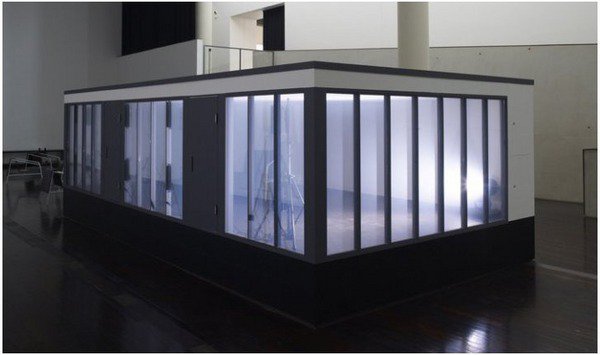Dominique Blais
dal 14/6/2013 al 26/10/2013
Segnalato da
14/6/2013
Dominique Blais
Musee d'Art Contemporain du Val-de-Marne - MAC/VAL, Vitry-sur-Seine
Les Grands Verres. On this occasion, the museum has invited the artist to imagine a project that aims to represent the relations between such a place and its architecture, its public and its works. Blais decided to question the museum's complex, necessary and nevertheless contradictory relation to light.

‘Born in 1974, Dominique Blais works on the sensorial and physical perceptions experienced by viewers in light and sound installations which play on the combination of the visible and invisible, the audible and the inaudible.’ (Raphaële Jeune)
This is the first time the artist’s work has been placed at the heart of a museum. On this occasion, MAC/VAL has invited the artist to imagine a project that aims to represent the relations between such a place and its architecture, its public and its works. How is space to be taken into account? What is the symmetrical relation between the inside and outside of a museum, between its missions and its envelope?
Dominique Blais wanted this project to reveal these different states, taking as its origin the value of experience, the adventure of research as the specificity of the work of artistic elaboration, the point being to show how, beyond the actual process of study, the path is always as important as its destination. At the beginning of this experience, the artist observed that many of the MAC/ VAL’s glass openings had been blocked off over the years because the excess luminosity was often detrimental to the apprehension, reading and, above all, conservation of the works. Blais therefore decided to question the museum’s complex, necessary and nevertheless contradictory relation to light – natural or artificial – as it performs its missions, in order to appreciate more fully the variations in the luminosity of the day, the alternation of the seasons, thus observing the poetry of the passing of light rays and the shadows they cast. In doing so he emphasizes the ways in which use can distort architecture.
The great expanses of glass in the main hall, the museum’s emblematic space, constitute the origin of this artistic process, as both particular volume and symbolic universe. They subtly penetrate the mysteries of the place, of its space, of what surrounds it and what traverses it. Is the museum a place that is open to the world, that reflects it, or must it be dedicated simply to the conservation of works which, when they leave the store room and are exposed to the light and to visitors, are in danger? For this is how Dominique Blais works, by questioning the places and situations that are proposed to him. He approaches each new invitation without assumptions, without pre-decided projects.
The genesis of his work is founded, above all, on attention to the space, to its users and its history. Dialogue then brings forth the problematic that the artist will formalise. Each of his projects reveals the singularity of his relation to the place, to the museum, as he brings out one of its character traits, a particularity, and in most cases its very essence. Here, that essence is twofold, contradictory. In the end, it is what constitutes both the strength and the weakness of the museums of our time. This new invitation revives the fresh hope of ‘Vivement demain,’ the fifth hanging of the collection, which explores in manifold ways the myth of the artist as questioner and prophet.
Alexia Fabre
Press Relations:
Anne Samson Communications
Christelle de Bernède Tel: 33 (0)1 40368435 / 33 christelle.debernede@annesamson.com
MAC/VAL
Musée d’art contemporain
du Val-de-Marne Place de la Libération 94400 Vitry-sur-Seine
Hours
Tuesday to Sunday: 12 am - 7 pm
Admission Full rate €5.00 — Concessions €2,5



